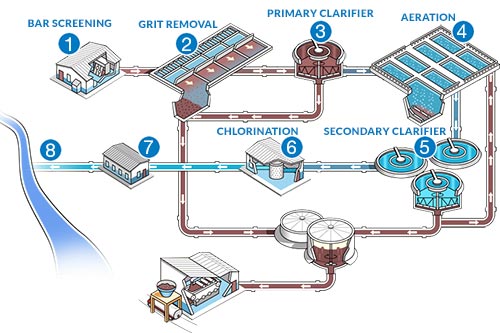How Wastewater Treatment Can Enhance Resource Reuse Options
Wiki Article
Recognizing Wastewater Treatment Processes and Their Ecological Impact
The details of wastewater treatment processes play a pivotal role in mitigating ecological obstacles connected with water pollution. Each stage, from preliminary to innovative therapies, is created to deal with certain contaminants, eventually guarding both public health and wellness and water ecosystems. However, despite technological advancements in treatment efficiency, substantial challenges linger, including the administration of residual pollutants and the ramifications of nutrient runoff. As we discover the complexities of these procedures, it becomes necessary to question exactly how far existing methods can evolve to satisfy the growing demands of sustainability and ecological preservation.Review of Wastewater Therapy
Just how is wastewater changed into a secure source for the environment? Wastewater treatment is a crucial procedure designed to eliminate contaminants from used water, therefore protecting public wellness and securing communities. This process starts with the collection of wastewater from household, commercial, and industrial sources, which is then routed to treatment centers.At these facilities, numerous physical, chemical, and organic techniques are used to treat the wastewater. Initial screening removes big particles, followed by sedimentation to separate much heavier solids. Consequently, biological treatments, such as turned on sludge processes, utilize bacteria to damage down natural issue. These approaches not only lower toxin degrees yet additionally assist in the healing of important nutrients.
The treated effluent can be safely discharged into natural water bodies or recycled for watering and commercial functions, promoting source preservation. Additionally, the therapy process creates biosolids, which can be repurposed as plant foods or soil amendments, further boosting sustainability.
Phases of Treatment Procedures
The wastewater therapy process generally consists of three primary stages: initial, primary, and second treatment. Each phase serves a distinct role in minimizing the contaminant tons and ensuring the effluent meets environmental standards prior to discharge.
The primary treatment stage concentrates on the physical separation of suspended solids from the wastewater. Via sedimentation, much heavier bits clear up at the end of sedimentation containers, forming sludge, while lighter materials, such as oils and oils, float to the surface area and are skimmed. This procedure significantly reduces the organic and inorganic lots in the wastewater.
Second therapy is a biological procedure aimed at more minimizing the concentration of natural issue. This stage is important for achieving the essential biochemical oxygen demand (FIGURE) decrease, ultimately leading to cleaner effluent ready for discharge or further treatment.

Advanced Therapy Technologies
Complying with the secondary treatment processes, progressed treatment modern technologies play an essential role in additional boosting the quality of dealt with wastewater. These innovations are made to remove residual impurities that are not effectively removed throughout primary and additional treatments, making sure the effluent fulfills rigid regulatory criteria.Among the commonly utilized innovative treatment approaches are membrane filtration, reverse osmosis, and advanced oxidation procedures. Membrane layer filtration, including microfiltration and ultrafiltration, is effective in dividing fine particles, pathogens, and colloids from the water (Wastewater). Reverse osmosis makes use of semi-permeable membranes to get rid of dissolved solids, leading to top quality water suitable for numerous applications
Advanced oxidation see this page processes (AOPs) employ solid oxidants to degrade organic contaminants, including pharmaceuticals and individual care products that are resistant to standard treatment. These approaches boost the biodegradability of complicated compounds, promoting their removal.
One more substantial technology is making use of biological nutrient removal processes, which particularly target nitrogen and phosphorus, preventing eutrophication in getting water bodies. Overall, advanced therapy innovations are crucial for accomplishing higher degrees of filtration, promoting water reuse, and securing public wellness while addressing the challenges connected with wastewater administration.
Ecological Advantages of Treatment
Numerous environmental benefits arise from effective wastewater treatment procedures that add to ecosystem health and sustainability. Largely, these procedures significantly reduce the release of hazardous contaminants into all-natural water bodies, which aids keep aquatic environments. By eliminating pollutants such as heavy steels, nutrients, and pathogens, treated wastewater reduces the threat of waterborne conditions and promotes biodiversity in marine settings.Furthermore, wastewater treatment centers usually use advanced innovations that enable water recycling and reuse. This practice not only saves fresh water sources but additionally lowers the need on natural water products. Enhanced nutrient elimination from wastewater can additionally stop eutrophication, a process that results in algal blooms and subsequent oxygen deficiency in water systems.
Additionally, efficient therapy processes can reduce greenhouse gas discharges, specifically methane and nitrous oxide, which are frequently released throughout unattended wastewater disintegration. By catching and using biogas from anaerobic digesters, facilities can transform waste into renewable resource, therefore adding to a reduction in nonrenewable fuel source reliance.
Difficulties and Future Patterns
While the ecological benefits of wastewater treatment are clear, a number of difficulties continue that prevent ideal outcomes in this field. One significant issue is maturing facilities, which typically causes inefficiencies and raised operational costs - Wastewater. Numerous therapy plants were designed years back, and their capabilities do not line up with modern demands, that include more stringent regulatory requirements and greater quantities of wastewater as a result of urbanization
Looking in advance, there is a growing emphasis on source healing and circular economic climate principles within wastewater treatment. Developments such as anaerobic digestion, which can generate biogas, and progressed filtering innovations are acquiring grip. These approaches not only enhance therapy efficiency however also promote sustainability.
Eventually, dealing with these challenges calls for collaboration amongst stakeholders, investment in innovation, and a commitment to recurring study. By embracing these trends, the wastewater therapy sector can evolve to fulfill the needs of a transforming setting and culture.
Final Thought
In final thought, wastewater therapy procedures play an important function in boosting ecological quality and public health. The multi-stage therapy structure, combined with advanced technologies, efficiently alleviates pollution and promotes lasting water management.Report this wiki page